Blue Mountains National Park
| Blue Mountains National Park | ||
|---|---|---|
| The Three Sisters rock formation made of sandstone | ||
|
|
||
| Location: | New South Wales , Australia | |
| Specialty: | Mountains with eucalyptus forests | |
| Next city: | Katoomba | |
| Surface: | 2470 km² | |
| Founding: | 1959 | |
|
|
||
The Blue Mountains National Park is a national park in the region of the Blue Mountains on the east side of the Great Dividing Range in the Australian state of New South Wales , about 80 km west of Sydney . The park is located on a plateau crossed by rivers and covers an area of 2470 km². The highest point of the park is Mount Werong at 1215 m , the lowest is the Nepean River at 20 m . The name of the park has its origin in the bluish air cloudiness caused by the eucalyptus trees and their essential oils .
The origin of the national park goes back to plans that provided for a much larger area than the area used today. In 1959 the Blue Mountains National Park was established and in 2000 it received an extended protection status as part of the Greater Blue Mountains World Heritage Area .
Two of the park's largest rivers, the Coxs River and the Wollondilly River , flow into Lake Warragamba , the main source of drinking water for Sydney. The Blue Mountains are part of the Sydney Basin , a sedimentary basin which consists of layers of up to 300 million year old sedimentary rock composed. The mountains, made up essentially of the rocks of the Narrabeen Group , have been raised above the basin by raising the western part of the basin. In recent geological times, large areas of the region have been covered with volcanic basalt , which has now largely been removed by erosion and has left behind a number of individual mountain peaks.
The Blue Mountains National Park is divided into two parts, a northern and a southern part, by the Great Western Highway and a number of localities that are combined to form the City of Blue Mountains . The north is bounded to the north by the Bells Line of Road . The Grose Valley is dominant here . In the southern part there is the Jamison Valley with the Three Sisters and the Megalong Valley .
Wildlife and vegetation
The Australian Echidna is relatively common in the open forests . Presumably some koalas , which were still common in this area around 1900, are still in the park. The nocturnal and therefore difficult to observe species include fox kusu and various flying squirrel hives . The denser forests are also inhabited by nasal sacs , broad-footed sac mice , swamp wallabies , and giant gliding sacs. The largest predator among the marsupials is the giant bag marten, which also mainly inhabits dense forests. The rainforests, for example, offer habitat for ringbuck and flying foxes. Bare-nosed wombats , red-necked wallabies , mountain kangaroos and eastern gray kangaroos live particularly in the more open areas, where grasses and woodland coexist . The largest predator in the region is the dingo , a feral dog. In addition, there are foxes, cats, horses and cattle in the park, which are not originally indigenous, but sometimes have a negative influence on the local fauna.
A pawsaber in the national park
Web links
- Blue Mountains National Park on nationalparks.nsw.gov.au









